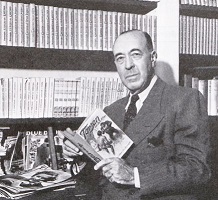
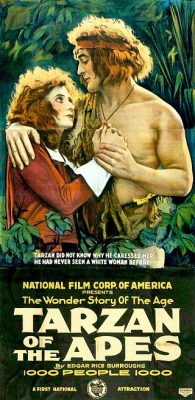 Tarzan, Lord of the Jungle (1951-1952) aired “The Strange Book of Araby” on September 13, 1951 and is only the 4th episode we have showcased since May of 2020. For newcomers, we repeat the introduction to several previous Tarzan episodes, the first from 2009 and the most recent from April of 2022, just over a year ago.
Tarzan, Lord of the Jungle (1951-1952) aired “The Strange Book of Araby” on September 13, 1951 and is only the 4th episode we have showcased since May of 2020. For newcomers, we repeat the introduction to several previous Tarzan episodes, the first from 2009 and the most recent from April of 2022, just over a year ago.
From 1932-36 Tarzan on radio consisted of three long-running serials: Tarzan of the Apes, Tarzan and the Diamond of Asher, and The Fires of Toth. Tarzan was played by silent film actor James H. Pierce and Jane was played by Edgar Rice Burroughs’s daughter Joan. Pierce had attended a party held by Burroughs where he met Joan. ERB asked Pierce if would appear as Tarzan in ERB’s next silent Tarzan picture. Pierce replied that he was to appear in another film titled Wings. ERB nevertheless convinced Pierce to become Tarzan and he gave up his role in Wings. Pierce’s role in Wings was then filled by a relative newcomer named Gary Cooper, and Wings would walk away with the first Oscar for what is now known as Best Picture in 1929. Such blow the fickle winds of Fate. On the up side, James Pierce would wed Joan Burroughs in 1928 and they would remain together until their deaths (Joan in 1972 and James in 1983).
(Above left: Movie Poster for the 1918 Tarzan of the Apes silent film – Above Right: ERB, 1875-1950)
(Photo below left: Joan and James Pierce photo cropped to show the left half of their wedding invitation, dated August 8, 1928. From the Danton Burroughs Archive Collection.)
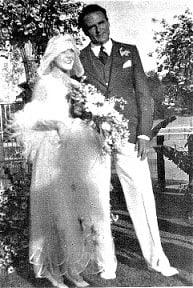 It is impractical to run lengthy serials here, though we have run a few consecutive episodes with specific self-contained adventures. Each of the 1930s Tarzan serials ran to approximately 40 episodes, give or take, and timed out from 8-12 minutes each. There would be a new Tarzan episode in the much longer story arc every two or three days throughout the week. After the trio of initial serials in the 1930s, the Golden Age of radio would produce no further Tarzan adventures until 1951, at which time his new exploits would run from January of 1951 through June of 1952 (and through July of 1953 if one counts syndicated rebroadcasts), when many radio shows were gradually being phased out in favor of television. Lamont Johnson now played the Lord of the Jungle, and in contrast to the earlier 1930s serials (and the Johnny Weismuller Tarzan films), Tarzan would speak intelligent English rather than the “Me Tarzan, you Jane” dialogue many have come to think of when the subject comes up.
It is impractical to run lengthy serials here, though we have run a few consecutive episodes with specific self-contained adventures. Each of the 1930s Tarzan serials ran to approximately 40 episodes, give or take, and timed out from 8-12 minutes each. There would be a new Tarzan episode in the much longer story arc every two or three days throughout the week. After the trio of initial serials in the 1930s, the Golden Age of radio would produce no further Tarzan adventures until 1951, at which time his new exploits would run from January of 1951 through June of 1952 (and through July of 1953 if one counts syndicated rebroadcasts), when many radio shows were gradually being phased out in favor of television. Lamont Johnson now played the Lord of the Jungle, and in contrast to the earlier 1930s serials (and the Johnny Weismuller Tarzan films), Tarzan would speak intelligent English rather than the “Me Tarzan, you Jane” dialogue many have come to think of when the subject comes up.
“The Strange Book of Araby” is one of the more intriguing episodes of this half hour 1951-52 run. It concerns the plight of a peaceful tribe being raided for its cattle (and its women to cook and serve the meals from this stolen bounty) by a rebel tribe of Arab soldiers. When one of the young women escapes, flees into the jungle, meets Tarzan and explains what has happened to her tribe, the Lord of the Jungle sets out to right this terrible wrong. He is aided by a certain Caliph he has known for years, a wise old man who convinces Tarzan to believe in the prophecies of a sacred tome known as The Sacred Book of Araby. The only problem is that it is written in a long-lost language no one can read, and Tarzan is skeptical of such a book that pretends to know the future. How this problem, and Tarzan’s skepticism are overcome form a most unusual tale, one that provides the clue to the defeat of the lawless Arab soldiers. And as an unexpected bonus we learn the meaning of Tarzan’s name in the language of the jungle, something many of Tarzan’s followers (fictional and real) have been curious to know since they first read of, or heard, this now famous name. So sit back, relax, and get ready to enjoy the exciting tale surrounding the secrets of a most curious book known only to few men, whose prophecies actually come to pass, challenging Tarzan’s beliefs, though he is eventually forced to believe the undeniable veracity of the words contained in “The Strange Book of Araby.”
Play Time: 26:26
{September 13, 1951 was a Thursday, so after listening to this thrilling episode of Tarzan, Lord of the Jungle, the neighborhood gang knew they had only to survive the next day of the new school year before they could head for the nearby newsstand, there to revel in the colorful covers of their favorite sf and fantasy pulps, and the mind-boggling stories they promised inside those covers. Famous fantastic Mysteries (1939-53) never failed to excite. It ran reprints of classic SF and Fantasy stories from eras gone by, and the gang fed on these highly imaginative adventures with abandon. Mary Gnaedinger was the magazine’s superb editor, and in 1951 the magazine was a bi-monthly. fantastic Adventures (1939-53) began as a companion magazine to SF’s first magazine Amazing Stories. It published lighter fare than Amazing early on, but a reliable source has written that it ended up publishing more or less the same sort of story as its predecessor but with an even more fantastical bent. It was a monthly in 1951. The Magazine of Fantasy & Science Fiction (1949-present) was the newcomer on the block alongside the other two, seeing its first issue in the Fall of 1949. For its first few years it ran classic reprints along with new material and was beginning to make quite a name for itself given the new direction in storytelling it promised. An indication of this new direction can be seen by the style of the cover art displayed below. F&SF was a bi-monthly in 1951 but with its August 1952 issue would assume a regular monthly schedule.}
[Left: Famous fantastic Mysteries, 10/51 – Center: fantastic Adventures, 9/51 – Right: F&SF, 10/51]
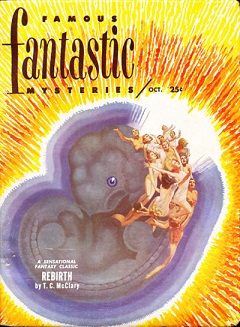
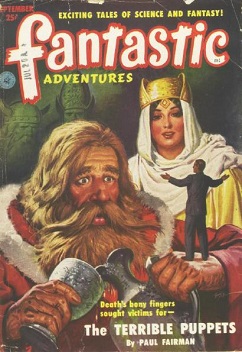
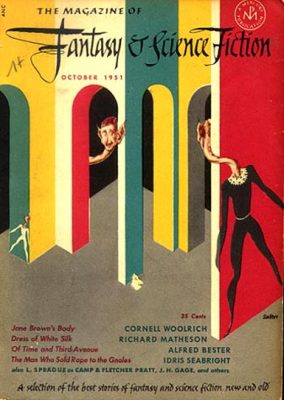
To view the entire list of weekly Old Time Radio episodes at Tangent Online, click here.